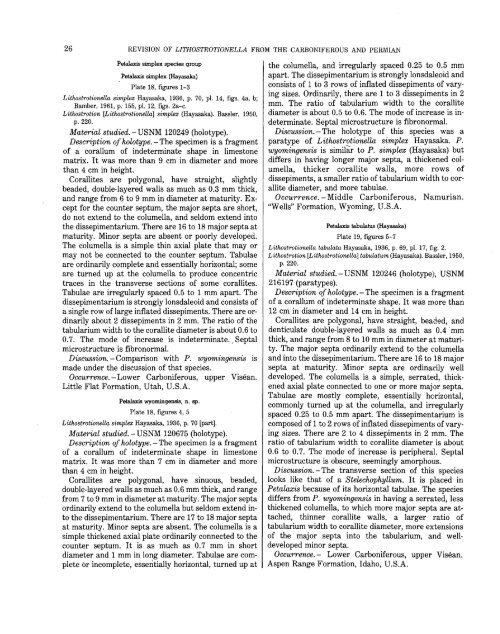Revision of Lithostrotionella - USGS
Revision of Lithostrotionella - USGS
Revision of Lithostrotionella - USGS
You also want an ePaper? Increase the reach of your titles
YUMPU automatically turns print PDFs into web optimized ePapers that Google loves.
26 REVISION OF LITHOSTROTIONELLA FROM THE CARBONIFEROUS AND PERMIAN<br />
Petala.xis simplex species group<br />
Petala.xis simplex {Hayasaka)<br />
Plate 18, figures 1-3<br />
<strong>Lithostrotionella</strong> simplex Hayasaka, 1936, p. 70, pl. 14, figs. 4a, b;<br />
Bamber, 1961, p. 155, pl. 12, figs. 2a-c.<br />
Lithostrotion [<strong>Lithostrotionella</strong>] simplex (Hayasaka). Bassler, 1950,<br />
p. 220.<br />
Material studied.-USNM 120249 (holotype).<br />
Description <strong>of</strong> holotype. -The specimen is a fragment<br />
<strong>of</strong> a corallum <strong>of</strong> indeterminate shape in limestone<br />
matrix. It was more than 9 em in diameter and more<br />
than 4 em in height.<br />
Corallites are polygonal, have straight, slightly<br />
beaded, double-layered walls as much as 0.3 mm thick,<br />
and range from 6 to 9 mm in diameter at maturity. Except<br />
for the counter septum, the major septa are short,<br />
do not extend to the columella, and seldom extend into<br />
the dissepimentarium. There are 16 to 18 major septa at<br />
maturity. Minor septa are absent or poorly developed.<br />
The columella is a simple thin axial plate that may or<br />
may not be connected to the counter septum. Tabulae<br />
are ordinarily complete and essentially horizontal; some<br />
are turned up at the columella to produce concentric<br />
traces in the transverse sections <strong>of</strong> some corallites.<br />
Tabulae are irregularly spaced 0.5 to 1 mm apart. The<br />
dissepimentarium is strongly lonsdaleoid and consists <strong>of</strong><br />
a single row <strong>of</strong> large inflated dissepiments. There are ordinarily<br />
about 2 dissepiments in 2 mm. The ratio <strong>of</strong> the<br />
tabularium width to the corallite diameter is about 0.6 to<br />
0. 7. The mode <strong>of</strong> increase is indeterminate. "Septal<br />
microstructure is fibronormal.<br />
Discussion. -Comparison with P. wyomingensis is<br />
made under the discussion <strong>of</strong> that species.<br />
Occurrence.- Lower Carboniferous, upper Visean.<br />
Little Flat Formation, Utah, U.S.A.<br />
Petalaxis wyomingensis, n. sp.<br />
Plate 18, figures 4, 5<br />
<strong>Lithostrotionella</strong> simplex Hayasaka, 1936, p. 70 [part].<br />
Material studied.-USNM 120675 (holotype).<br />
Description <strong>of</strong> holotype. -The specimen is a fragment<br />
<strong>of</strong> a corallum <strong>of</strong> indeterminate shape in limestone<br />
matrix. It was more than 7 em in diameter and more<br />
than 4 em in height.<br />
Corallites are polygonal, have sinuous, beaded,<br />
double-layered walls as much as 0.6 mm thick, and range<br />
from 7 to 9 mm in diameter at maturity. The major septa<br />
ordinarily extend to the columella but seldom extend into<br />
the dissepimentarium. There are 17 to 18 major septa<br />
at maturity. Minor septa are absent. The columella is a<br />
simple thickened axial plate ordinarily connected to the<br />
counter septum. It is as much as 0.7 mm in short<br />
diameter and 1 mm in long diameter. Tabulae are complete<br />
or incomplete, essentially horizontal, turned up at<br />
the columella, and irregularly spaced 0.25 to 0.5 mm<br />
apart. The dissepimentarium is strongly lonsdaleoid and<br />
consists <strong>of</strong> 1 to 3 rows <strong>of</strong> inflated dissepiments <strong>of</strong> varying<br />
sizes. Ordinarily, there are 1 to 3 dissepiments in 2<br />
mm. The ratio <strong>of</strong> tabularium width to the corallite<br />
diameter is about 0.5 to 0.6. The mode <strong>of</strong> increase is indeterminate.<br />
Septal microstructure is fibronormal.<br />
Discussion.-The holotype <strong>of</strong> this species was a<br />
paratype <strong>of</strong> <strong>Lithostrotionella</strong> simplex Hayasaka. P.<br />
wyomingensis is similar to P. simplex (Hayasaka) but<br />
differs in having longer major septa, a thickened columella,<br />
thicker corallite walls, more rows <strong>of</strong><br />
dissepiments, a smaller ratio <strong>of</strong> tabularium width to corallite<br />
diameter, and more tabulae.<br />
Occurrence.- Middle Carboniferous, Namurian.<br />
"Wells" Formation, Wyoming, U.S.A.<br />
Petalaxis tabulatus (Hayasaka)<br />
Plate 19, figures 5-7<br />
<strong>Lithostrotionella</strong> tabulata Hayasaka, 1936, p. 69, pl. 17, fig. 2.<br />
Lithostrotion [<strong>Lithostrotionella</strong>] tabulatum (Hayasaka). Bassler, 1950,<br />
p. 220.<br />
Material studied.-USNM 120246 (holotype), USNM<br />
216197 (paratypes).<br />
Description <strong>of</strong> holotype.-The specimen is a fragment<br />
<strong>of</strong> a corallum <strong>of</strong> indeterminate shape. It was more than<br />
12 em in diameter and 14 em in height.<br />
Corallites are polygonal, have straight, beaded, and<br />
denticulate double-layered walls as much as 0.4 ·mm<br />
thick, and range from 8 to 10 mm in diameter at maturity.<br />
The major septa ordinarily extend to the columella<br />
and into the dissepimentarium. There are 16 to 18 major<br />
septa at maturity. Minor septa are ordinarily well<br />
developed. The columella is a simple, serrated, thickened<br />
axial plate connected to one or more major septa.<br />
Tabulae are mostly complete, essentially horizontal,<br />
commonly turned up at the columella, and irregularly<br />
spaced 0.25 to 0.5 mm apart. The dissepimentarium is<br />
composed <strong>of</strong> 1 to 2 rows <strong>of</strong> inflated dissepiments <strong>of</strong> varying<br />
sizes. There are 2 to 4 dissepiments in 2 mm. The<br />
ratio <strong>of</strong> tabularium width to corallite diameter is about<br />
0.6 to 0. 7. The mode <strong>of</strong> increase is peripheraL Septal<br />
microstructure is obscure, seemingly amorphous.<br />
Discussion. -The transverse section <strong>of</strong> this species<br />
looks like that <strong>of</strong> a Stelechophyllum. It is placed in<br />
Petalaxis because <strong>of</strong> its horizontal tabulae. The species<br />
differs from P. wyomingensis in having a serrated, less<br />
thickened columella, to which more major septa are attached,<br />
thinner corallite walls, a larger ratio <strong>of</strong><br />
tabularium width to corallite diameter, more extensions<br />
<strong>of</strong> the major septa into the tabularium, and welldeveloped<br />
minor septa.<br />
Occurrence.- Lower Carboniferous, upper Visean.<br />
Aspen Range Formation, Idaho, U.S.A.

















